Cartography Fun: Make a Map and Create a World

When I was a teenager, back in the Dark Ages before cell phones, home computers, internet, and televisions in every room, I found myself confined to my bed, flat on my back, for what seemed like a very long time, after a spinal injury. As a hyperactive, always outside kind of kid, this confinement was difficult, even if it did get me out of having to do my chores.
Reading was one of my favorite pastimes, although I usually read sitting in a fork at the top of a tree or in the hammock in the back yard. Lying there in my bed, it didn’t take me long to read and re-read my personal book collection. Then, to help me pass the time, I was presented with The Hobbit and a box set of The Lord of the Rings. My mother hoped those four thick volumes would keep me entertained until the doctor released me. That was the first time I encountered a book (other than textbooks) that included a map. I spent hours studying the maps in those books, practicing saying the names of landmarks, kingdoms, and noteworthy places in Bilbo’s adventure with the dwarves and Frodo’s quest to destroy the Ring of Power. Having a map that showed me the world I was reading about added so much more depth to the story…
Since then I’ve read and seen many more books that include maps that illustrate the worlds their authors created and which truly add depth and detail to the stories they shared.
Many years after I first read the words, “In a hole in the ground there lived a hobbit,” I encountered J. K. Rowling’s Harry Potter series, and read about the marvelous Marauder’s Map. What could be more amazing and fun than a magical map that appears and disappears at your command, shows you whatever you ask of it, and helps you evade those troublesome individuals in your life? Wonderful! I’ve been trying to figure out how to make one of those for years!
While I’m still working out how to create a magical marauder’s map of my own, why don’t we create a map of a magical land from our own imaginations?
Creating fantasy maps has actually become quite popular. A simple Google search will yield countless results. There’s even open source software to help you create and illustrate a map on your computer. Here I will share a simple and fun way to create an imaginary world the old fashioned way, on paper, and fill it with geographical features and populate it with all manner of creatures and people. Your own imagination is the only limit to what you can add to your map,… and we all know there is no limit to the human imagination.
The first thing you will have to do is decide in your paper. Plain white printer paper can work great, and is easy to find. There is also construction paper, drawing paper, tinted art paper, watercolor paper,… Even shipping paper can work great, and usually will come to you with some wrinkles and creases already in it. More on that soon… If you have more time, you could try staining your paper with tea, coffee grounds, or coffee. That changes the texture of the paper, and allows the color to become uneven, which can add to the ‘antiqueness’ of the paper.
Here are some examples:
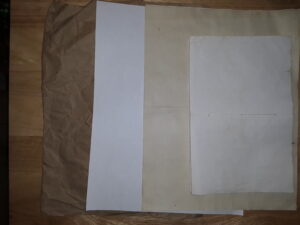
On the left is some shipping filler paper from a package. Next is a sheet of regular white printer paper. To the right of that is a piece of printer paper that soaked in coffee for an hour or so. Finally, there is a sheet that was in a bath of coffee grounds and water.
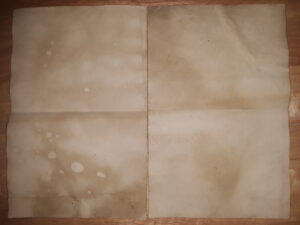
I accidentally left some paper soaking in coffee overnight, and that may be my best ‘antique’ paper. It has spots and irregular coloring which I find really fun.
Once you’ve decided on your paper, you need to create your major lands, oceans, and islands. Dried beans, sand, pea gravel, buttons, beads, or anything similar is great for creating such features. Try to use objects that won’t roll off of your paper and work surface. I used dried rice. After placing your map paper on top of a larger piece of paper or newsprint, pour some on the paper.

Shift it around until you like the shapes. Remember to keep it irregular so that you have interesting shorelines. Also have small bunches here and there that will become islands if your shape is a landmass, or water if your shape is a sea or inland ocean.
Once you are happy with your shapes, grab a pencil, pen, or marker, and prepare to take your time and focus on your work. I’m going to use a pen so that it will be easier to see in the pictures. Using a pencil, especially a mechanical pencil, would be a great choice, allowing for adjustments and edits along the way.
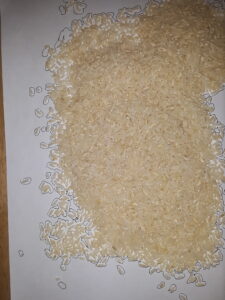
Trace around your shapes slowly and carefully, trying to get close without disturbing your material.
Don’t forget to trace around the stray bits. What’s a world without islands for pirate treasure, exploration, and secret hideouts?
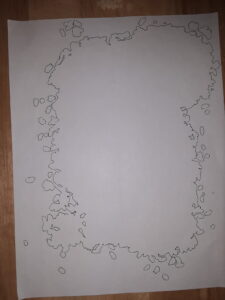
Once the tracing is complete, carefully remove the rice, beans, etc. back into a cup or bowl. You’re going to use it again shortly. Look over your drawing and fill in anywhere the line is broken. You now have the beginnings of your very own fantasy world. It’s time to create some geography.
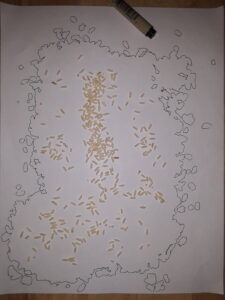
Now take some rice, or whatever you are using, out and scatter it around inside the large shape. These smaller shapes will become lakes, inland seas, marshes, swamps, oases, forests, mountains and mountain ranges, gorges, volcanoes, and caves. They can also become settlements, villages, towns, cities, forts, castles, etc.
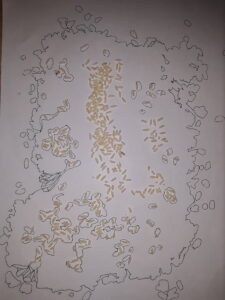 Once you like the arrangement, trace around the shapes just like before. This time I used a pen for everything except the long collection of rice in the center of the map.
Once you like the arrangement, trace around the shapes just like before. This time I used a pen for everything except the long collection of rice in the center of the map.
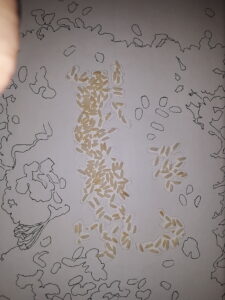
I planned to make that into a mountain range, so I traced around it with a pencil. That way, it will look better when I draw in the mountains.
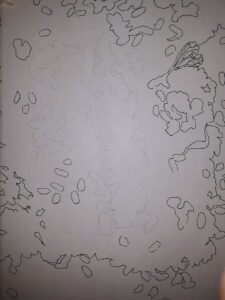
OK. Now the basic land forms are in place, it’s time to start creating the landscape of the fantasy world. There are as many ways to represent geographical features of the world as there are artists drawing maps. A simple online search can offer countless examples. The symbols on your map can be as simple or as complex as you choose to make them. They can be representational, looking like what they represent, or they can be as simple as dots, circles, and squares, requiring a key to decipher them. Here are a few I used on my map:
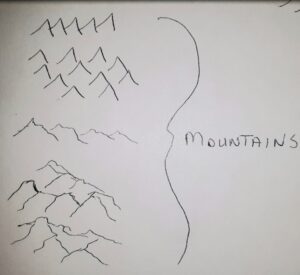
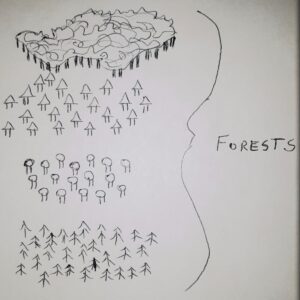
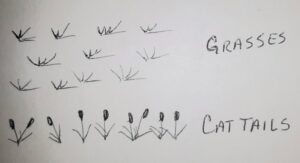

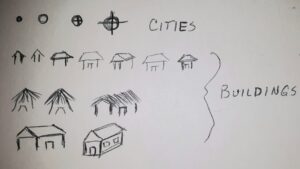

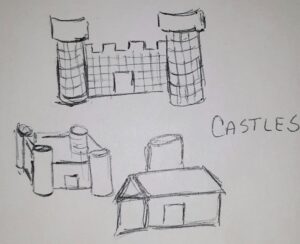
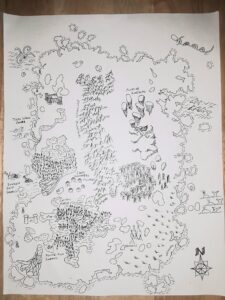
The drawings on the map don’t have to be perfect. Imperfection adds to the character of the map. I took my time creating my fantasy map. I didn’t add lots of cities to mine. I did, however, add sunken ships, whales and dolphins, two sea creatures, and a dragon, as well as a kingdom of floating islands and lakes of gold.
A good map should always have a compass rose or some symbol designating the directions, a legend, which explains the symbols and colors used on the map, a scale bar, which explains distances on the map, and a title. There are other parts like longitude and longitude, contour lines, and inserts, which can also be added. My map was getting rather full, so I added a simple compass rose on the lower right, and left off the key since my symbols were rather self-explanatory. I left off the scale and haven’t named my world, yet, so it doesn’t have a title. Perhaps people could suggest some names to me…
It’s fun to make up names for the locations on your map. You can use your native language, or follow the examples of J.R.R Tolkien and others, and create your own language. I used English on this map. Make sure you place the names in places where they can be seen clearly, and write large enough that they can be read, even if the language is as imaginary as the rest of the map. You want people to enjoy the writing as much as the drawing.

Now the fantasy map is drawn and labelled, you could stop here. Or you could have some fun and do a bit more. Add some color to it!
Once you have a drawn, labelled, and colored map, this could be a good place to stop. But antique maps don’t look so nice and neat, do they? Old maps, and even modern maps that have been used a few times, are full of folds and creases, and maybe a few years and stains.
 In order to make your fantasy map look old and ancient, you have to do something that seems to make no sense if you’re really proud of your work so far. It’s hard to do, but ball up your map. Crumple it up as small as you can, unfold it, and ball it up again. The more you do this, the more you will notice that the feel of the paper will change, becoming more ‘cloth-like.’ Here’s the back of my map after a few ‘ball-ups,’ where the creases are easier to see.
In order to make your fantasy map look old and ancient, you have to do something that seems to make no sense if you’re really proud of your work so far. It’s hard to do, but ball up your map. Crumple it up as small as you can, unfold it, and ball it up again. The more you do this, the more you will notice that the feel of the paper will change, becoming more ‘cloth-like.’ Here’s the back of my map after a few ‘ball-ups,’ where the creases are easier to see.
And the front…
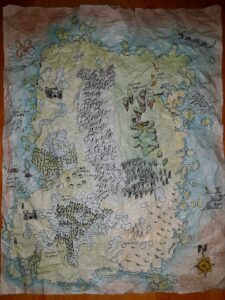
There’s just one thing left to do – write a story about the world you just created!
The map I made was of an imaginary land. It could be very inspiring, though, to look at real maps in order to get ideas about how to make yours. NASA is a great source for maps of Earth and other places in the Solar System.
Here is a list of sites where NASA maps can be found:
NASA Earth Ovservatory: Global Maps
NASA Solar System Exploration: Not exactly maps, interactive globes!
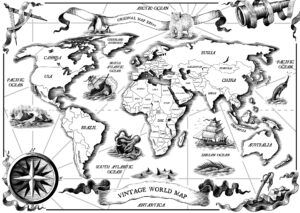
Old World map from the 1600’s
A Few Books With Maps in the Story
The Boy Who Loved Maps – Kari Allen, G. Brian Kara’s, ill
Henry’s Map – David Elliot
The Map Trap – Andrew Clements
Once Upon a Time Map Book – B. G. Hennessy, illustrated by Peter Joyce
The Paper Kingdom – Helena Ku Rhee, illustrated by Pascal Campion
Online Options to Try for Creating Fantasy Maps
Azgaar Fantasy Map Generator – free map creation software
Donjon – all free, and full of resources and options, this site is oriented toward role-playing games
Inkarnate – there’s a free and a paid version, but the free version has a fair selection of resources
World Anvil – there’s a tiered system of subscriptions, including a free level. This site allows you to keeps notes, write histories, and create stories, as well as create maps
Resources
The Hobbit or There and Back Again, Enhanced Edition, J. R. R. Tolkien, New York: Houghton Mifflin Harcourt, 1995
Geographia: From Antiquity to the Space Age, NASA Landsat Science
5 Amazing Free Fantasy Map Builders – Sean B., November 12, 2019
5 Best Map-Making Software for Worldbuilding – Janet Forbes, March 12, 2020
19 Great Free or Low Cost Digital Mapping Tools for Tabletop Games, RPG Map Making Tools – Moe T., October 16, 2022

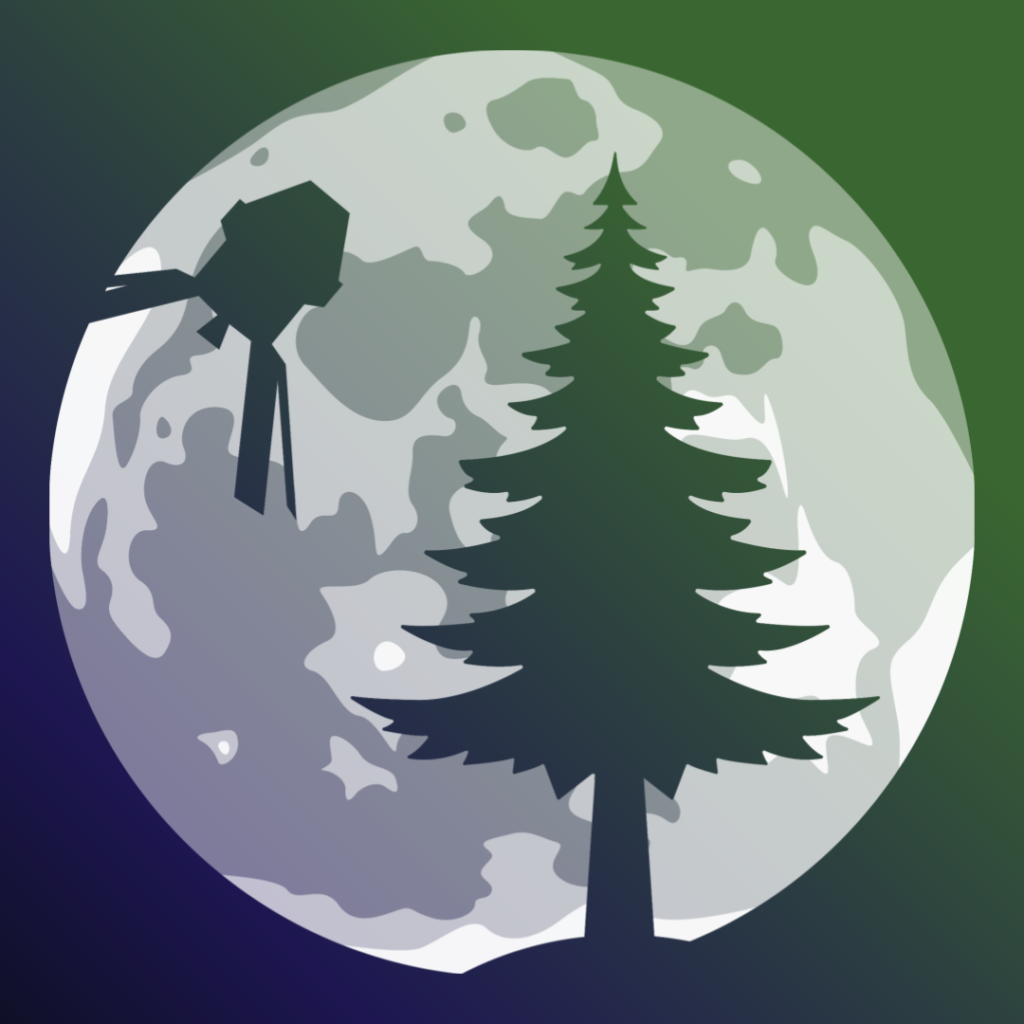
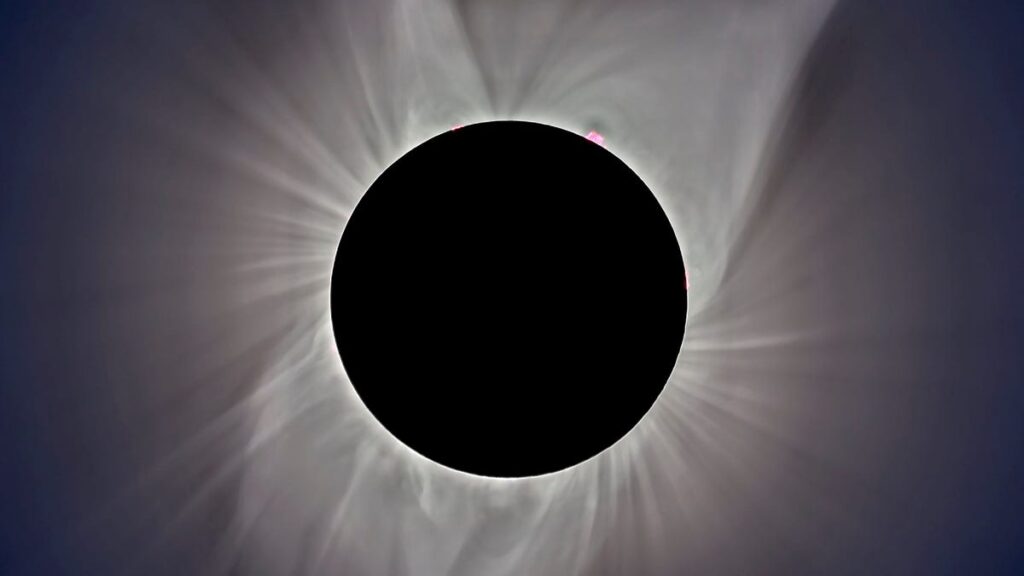

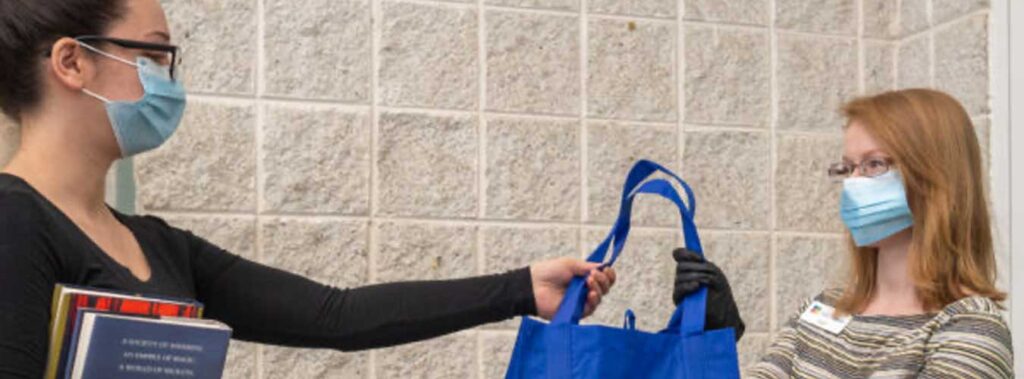

Responses